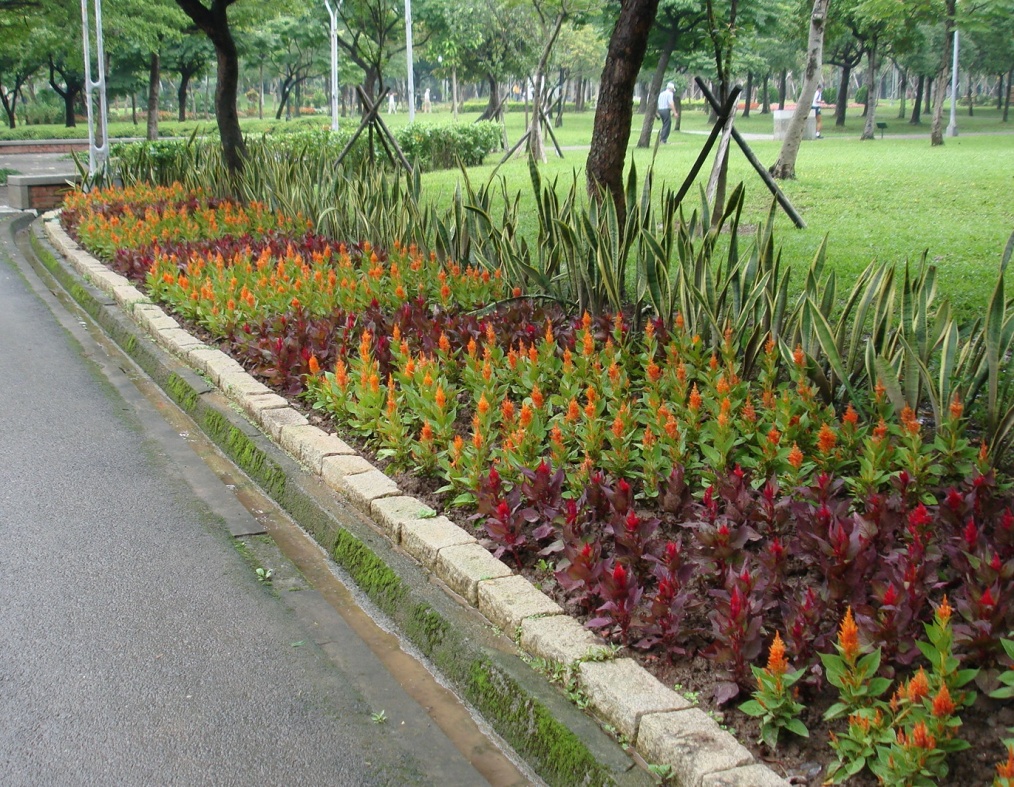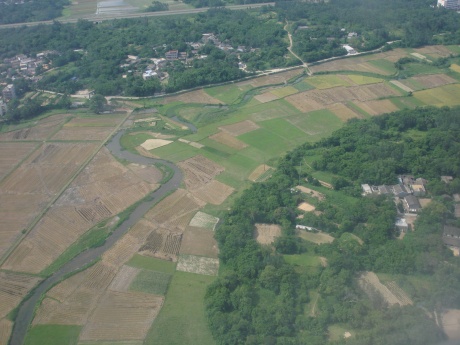In spite of the abundant Chinese people around San Francisco and the Bay Area there are few to zero examples of Chinese gardens to be seen. Most immigrants are usually too busy working to bother with the landscape outside. Some fruits and vegetables are one thing, but a place to contemplate nature and connect to the mythical world?! What is the worth of a flower?
Here are some pictures from Taiwan and southern China to get inspired. The little neighborhood park is a good place to start. It is where people do tai chi in the morning, take walks, and chat with old friends. Six sided structure, concrete columns disguised as old timber with branch stubs.
In larger parks, annual beds may be planted at the entrances. These are parks good for strolling and meeting local trees. Mother -in-law’s tongue Sansevieria is the frame of the flower bed, Celosia in the foreground.
The locals are hungry; urban agriculture is hip and happening! Chives, onions, and Chinese lettuce hang out in containers on a street corner, ready for a stir fry.
This is a green roof in the subtropics. Happy are the bromeliads and ferns in the humid heat. Timber is Taiwan cypress. A dominant fern on the roof is the bird’s nest fern Asplenium.
Ancient systems of water catchment and conservation. Big ceramic jars at the bottom of tiled roofs. Stone for walls and paths are volcanic rock quarried on site.
Always nice to wash your hands and rinse off the sweaty forehead after a hot, humid, and sticky hike. Chamaecyparis taiwanensis for a water trough.
At the entrance to a garden, one finds a novel use for roots. No stump grinder here; maybe try the compressed air excavator?
Rather than a perfect sphere of polished granite, there is a gnarly chunk of rock on a pedestal in the garden. Pitted and carved by the elements; asymmetric; ferns and moss growing all over it. Hmm…. What is the under current of this aesthetic?
Besides gnarled old branches and ancient rocks, the garden is home to miniature landscapes in containers. Let’s cultivate a relationship with the universe through potted plants. This delightful art requires a lifetime of patience and care…
One of the most entertaining things to do in the garden is to hang out with your friends, drink tea, play the flute, and compose some poetry. Tables and chairs are essential. Stone and wood, some shade, and a nice mix of chrysanthemum flowers and pu-er tea leaves. Smell the magnolia blossums, gaze upon the willow and mulberry trees swaying in the wind.
More tea!
Let’s have one more cup of tea before the party ends, and everyone goes their separate ways.
In the garden grow stories that connect the flowers and trees, stones and mountains, people and nature. The element of mythology is essential in any garden design. Characters help to define the garden, and give meaning to culturally important plants. The regal Nepalese/Indian Buddha was transformed in the Chinese imagination into a smiling, short, round, bald man. Poor and content, drinking….tea! Camellia sinensis.
Quan Yin in the garden hears the cries of misery and woe; compassion is her being. With her assistance, hell is turned into paradise, and the soul blooms out of a lotus flower.
Lotus emerge out of the mud and bathe in pure light. Water is an essential element in the garden.
Teacher and student. Scholar and apprentice. Many of life’s lessons are learned in the garden through work, study, and observation of nature’s cycles and patterns.
Before Muhammad, Jesus, Buddha, Confucius, and Lao-Tzu spread their teachings in China, people followed folk religion rooted in the hearth, the farm, the forest, the valleys, and the mountains. People prayed to the ancestors, meditated near natural power spots (waterfalls, caves, and volcanoes), and told stories about mythical creatures that once lived on earth (dragons and phoenixes). Temples built atop or within large gardens and parks are focal points of bright colors amidst the dense greenery. In towns, temples contrast sharply with the drab buildings. Dragons often ride on the ridge line of the roofs.
On garden islands, dragons spew water.
The curve of dragons’ backs can be seen atop garden houses.
Is there a dragon under the bridge?
In the curves of a flowing river…
Peace and harmony – that is the goal of a garden. Forget the busy running around; the cars in traffic and honking horns; the needy electronic devices; the mind in three or four or five places at the same time. Breathe in and out with the earth in a patch of heavenly oasis.
In the end, we pay our respects to the people who take care of the garden. Everyday, the gardener grows and cares for the flowers and trees. The gardener is the one who plays the role of the designer and creator. Look into a flower and you will see yourself.























Thanks for finally talking about >23. Notes on Chinese gardens
– design and construction | Mission Azul <Loved it!
chanel リボン バッグ